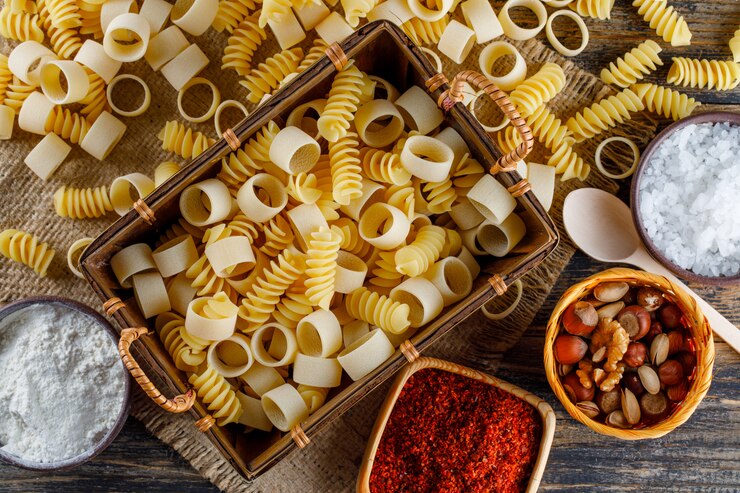Mafalde, a lesser-known yet captivating type of pasta, has been gaining popularity in culinary circles for its unique shape and versatility. Originating from Italy, this ribbon-like pasta is not only delicious but also rich in history and tradition. In this article, we will delve into the origins, characteristics, preparation methods, and creative ways to enjoy mafalde. By the end, you’ll understand why this pasta deserves a place in your kitchen and on your dinner table.
The Origins of Mafalde
Mafalde hails from the regions of Campania and Lazio in Italy, specifically associated with the city of Naples. Named after Princess Mafalda of Savoy, this pasta reflects the Italian culture of honoring important figures through culinary creations. Traditionally, mafalde was handmade, reflecting the artisanal nature of Italian cuisine, where each shape and texture has a purpose.
The pasta’s unique appearance, characterized by its wavy edges and flat surface, allows it to hold sauces exceptionally well. This design not only enhances the flavor of dishes but also adds visual appeal, making it a favorite among chefs and home cooks alike.
Characteristics of Mafalde
Mafalde is often compared to other pasta shapes such as fettuccine and pappardelle, but it stands out due to its distinctive wavy edges. Typically, mafalde comes in two varieties: mafaldini, which is narrower and thinner, and mafalde, which is wider and thicker. The width and texture make it an excellent candidate for a variety of sauces, from rich, meaty ragus to lighter cream-based sauces.
One of the key characteristics of mafalde is its ability to hold onto sauces, which enhances the overall dining experience. The ruffled edges create small pockets that trap sauce, ensuring that each bite is bursting with flavor. Additionally, mafalde has a firm texture that holds up well when cooked, making it ideal for various dishes.
How to Prepare Mafalde
Preparing mafalde is similar to cooking other types of pasta, but with a few specific considerations to achieve the best results. Here’s a step-by-step guide to cooking mafalde perfectly.
Cooking Mafalde
- Boil Water: Start by bringing a large pot of salted water to a rolling boil. The general rule of thumb is to use one tablespoon of salt per gallon of water.
- Add Mafalde: Once the water is boiling, add the mafalde. Stir gently to prevent it from sticking together.
- Cook Time: Mafalde typically takes about 8 to 12 minutes to cook, depending on its thickness. It’s essential to taste the pasta a minute or two before the suggested cooking time to achieve the desired al dente texture.
- Drain and Reserve Water: Once cooked, drain the mafalde in a colander but reserve a cup of pasta water. This starchy water can help adjust the consistency of your sauce if needed.
- Combine with Sauce: In a pan, add your preferred sauce, and then toss in the drained mafalde. Use the reserved pasta water to thin out the sauce if necessary.
- Serve and Enjoy: Plate your mafalde’s and finish with your choice of toppings, such as grated cheese, herbs, or a drizzle of olive oil.
Creative Ways to Enjoy Mafalde
Mafalde’s versatility allows it to shine in a variety of dishes. Here are some creative recipes to inspire you:
Mafalde with Ragu Sauce
This traditional Italian dish highlights the rich flavors of a meat sauce. The ruffled edges of mafalde pair beautifully with the chunky texture of the ragu, ensuring that every bite is flavorful.
Ingredients:
- 400g mafalde’s
- 500g ground beef or pork
- 1 onion, diced
- 2 cloves garlic, minced
- 400g canned tomatoes
- Olive oil
- Fresh basil
- Salt and pepper
Instructions:
- In a large skillet, heat olive oil and sauté onion and garlic until translucent.
- Add the ground meat and cook until browned.
- Pour in the canned tomatoes, season with salt and pepper, and let simmer for about 30 minutes.
- Cook mafalde’s according to package instructions and combine with the ragu sauce.
- Serve with fresh basil and grated Parmesan cheese.
Mafalde with Creamy Mushroom Sauce
For a vegetarian option, a creamy mushroom sauce complements mafalde’s texture perfectly. This dish is both comforting and indulgent.
Ingredients:
- 400g mafalde’s
- 250g mushrooms, sliced
- 200ml heavy cream
- 1 onion, diced
- 2 cloves garlic, minced
- Olive oil
- Fresh parsley
- Salt and pepper
Instructions:
- Heat olive oil in a pan and sauté onions and garlic until fragrant.
- Add mushrooms and cook until golden brown.
- Stir in the heavy cream and let simmer for a few minutes, seasoning with salt and pepper.
- Cook mafalde as directed and combine with the creamy mushroom sauce.
- Garnish with fresh parsley before serving.
Mafalde Salad with Roasted Vegetables
Mafalde’s can also be enjoyed cold as a pasta salad. Roasted vegetables add a depth of flavor that pairs well with the pasta.
Ingredients:
- 400g mafalde’s
- 1 zucchini, diced
- 1 bell pepper, diced
- 1 red onion, diced
- Olive oil
- Balsamic vinegar
- Salt and pepper
- Fresh mozzarella balls
Instructions:
- Preheat the oven to 200°C (400°F).
- Toss zucchini, bell pepper, and onion in olive oil, salt, and pepper. Roast in the oven for about 20-25 minutes.
- Cook mafalde’s as per the package instructions and let cool.
- In a bowl, combine the cooled mafalde’s, roasted vegetables, mozzarella, and a drizzle of balsamic vinegar.
- Toss well and serve chilled.
The Nutritional Benefits of Mafalde
Mafalde’s, like many other pasta varieties, can be part of a balanced diet. When made from whole wheat or enriched flour, mafalde’s offers several nutritional benefits:
- Complex Carbohydrates: Pasta is a great source of energy due to its carbohydrate content, which is essential for maintaining energy levels throughout the day.
- Fiber: Whole wheat mafalde’s contains dietary fiber, which aids digestion and promotes a feeling of fullness.
- Protein: Pasta made from durum wheat provides a moderate amount of protein, essential for muscle repair and growth.
When paired with vegetables, lean proteins, and healthy fats, mafalde’s can be part of a nutritious and balanced meal.
Conclusion
Mafalde is a delightful pasta that deserves more attention in the culinary world. Its unique shape, versatility, and rich history make it an exciting choice for home cooks and chefs alike. Whether enjoyed with a hearty ragu, a creamy sauce, or as a refreshing pasta salad, mafalde’s can elevate any meal. By exploring its origins and trying out different recipes, you can fully appreciate this unique pasta and its place in Italian cuisine.
Next time you’re in the grocery store, consider adding mafalde’s to your cart. With its ability to hold sauces beautifully and its potential for creative dishes, it’s sure to become a staple in your kitchen.
FAQs
What is mafalde?
Mafalde is a type of pasta characterized by its flat, ribbon-like shape with wavy edges, originating from Italy, specifically the regions of Campania and Lazio.
How do I cook mafalde?
To cook mafalde, boil salted water, add the pasta, and cook for 8 to 12 minutes until al dente. Drain and combine with your choice of sauce.
What dishes can I make with mafalde?
Mafalde’s can be used in various dishes, including ragu sauce, creamy mushroom sauce, and pasta salads with roasted vegetables.
Is mafalde healthy?
Mafalde’s can be part of a healthy diet, especially when made from whole wheat flour, as it provides complex carbohydrates, fiber, and protein.
Can I use mafalde‘s in place of other pasta shapes?
Yes, mafalde’s can often be substituted for fettuccine or pappardelle in recipes due to its similar texture and ability to hold sauces.







